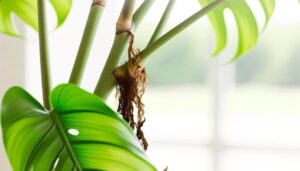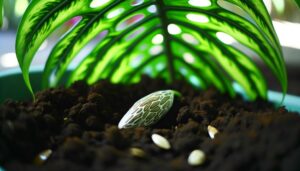Monstera Acacoyaguensis Common Problems
Common issues with Monstera Acacoyaguensis include yellowing leaves, pest infestations, improper watering, inadequate light, and root rot. Yellow leaves indicate nutrient deficiencies, often resolved by soil testing and proper fertilization.
Pests like spider mites and aphids cause discoloration and curling; neem oil and insecticidal soap can assist. Overwatering leads to root rot, while underwatering causes desiccation—monitor soil moisture attentively.
Insufficient light hinders photosynthesis and results in elongated stems and smaller leaves; ensure bright, indirect light. Root rot, recognized by stunted growth and a foul odor, necessitates good drainage and aeration.
Explore further to optimize your Monstera's well-being.
Key Takeaways
- Yellowing leaves often signal nutrient deficiencies; conduct a soil test and amend with appropriate fertilizers.
- Pest infestations like spider mites and aphids cause discolored spots and leaf curling; use neem oil or insecticidal soap.
- Overwatering leads to root rot and stunted growth; ensure proper drainage and allow soil to dry before watering.
- Insufficient light results in elongated stems and smaller leaves; place Monstera in bright, indirect light.
- Root rot caused by waterlogged soil and pathogenic fungi shows yellowing leaves and foul odor; repot in fresh soil and prune affected roots.
Yellowing Leaves
Yellowing leaves on your Monstera Acacoyaguensis typically indicate chlorosis, often resulting from nutrient deficiencies or improper watering practices. Chlorosis occurs when chlorophyll production is disrupted, causing leaves to lose their vibrant green color.
You'll want to check for deficiencies in essential nutrients like nitrogen, magnesium, or iron. Conduct a soil test to determine nutrient imbalances and amend with appropriate fertilizers.
Overwatering can also lead to root oxygen deprivation, causing root rot, which inhibits nutrient uptake. Make sure your plant's soil has good drainage and avoid waterlogging by letting the top inch of soil dry out between waterings.
Correcting these issues promptly is important for restoring your Monstera's health and preventing further chlorosis.
Pest Infestations
Pest infestations on your Monstera Acacoyaguensis often manifest through visible damage such as discolored spots, leaf curling, or the presence of tiny insects like spider mites, aphids, or mealybugs.
Spider mites create fine webbing on the underside of leaves, leading to chlorosis and necrosis. Aphids excrete honeydew, fostering sooty mold growth. Mealybugs appear as white, cotton-like masses, causing leaf distortion and stunted growth.
Combat these pests using integrated pest management (IPM) strategies, including neem oil applications, insecticidal soaps, and introducing natural predators like ladybugs. Regularly inspect your plant, especially the underside of leaves, for early detection.
Maintaining ideal humidity levels and cleanliness can also mitigate pest proliferation, ensuring your Monstera remains healthy and vibrant.
Improper Watering
Improper watering practices often result in root decay, leaf yellowing, and overall deterioration in your Monstera Acacoyaguensis. When you overwater, excess moisture creates oxygen-deprived conditions in the soil, encouraging the growth of harmful fungi like Pythium and Phytophthora. These pathogens attack the root system, causing decay and hindering nutrient uptake.
On the contrary, underwatering leads to desiccation, stunted growth, and chlorosis due to inadequate hydration and nutrient absorption. Monitoring soil moisture levels is essential; use a moisture meter to avoid extremes.
Ensure the potting medium has good drainage and aeration properties. Water when the top inch of soil feels dry, and always use room-temperature water to prevent shock to the roots.
Inadequate Light
Insufficient light conditions can significantly hinder the photosynthetic efficiency of your Monstera Acacoyaguensis, resulting in elongated stems, smaller leaves, and an overall weakened plant structure.
Limited light diminishes chlorophyll production, affecting the plant's capacity to produce glucose through photosynthesis. This leads to etiolation, where the stems elongate unusually in pursuit of light, and leaf chlorosis, characterized by yellowing leaves due to chlorophyll deficiency.
To enhance growth, position your Monstera in bright, indirect light. Direct sunlight can lead to photoinhibition, harming the chloroplasts, while low light levels don't provide the necessary energy for robust growth.
Monitoring light intensity using a lux meter can help guarantee your plant receives the ideal light conditions for peak health and vitality.
Root Rot
Root rot, often caused by waterlogged soil and poor drainage, severely compromises the health of your Monstera Acacoyaguensis by damaging its root system and impeding nutrient uptake. This condition fosters a conducive environment for pathogenic fungi like Pythium and Phytophthora, which attack and decompose the root tissues.
You'll notice symptoms such as yellowing leaves, stunted growth, and a foul odor emanating from the soil. To combat root rot, make sure your plant's pot has adequate drainage holes and use a well-aerated, chunky potting mix. Avoid overwatering; allow the top inch of soil to dry before watering again.
If root rot is present, prune the affected roots and repot in fresh, sterile soil to halt the progression of the disease.
Conclusion
In caring for your Monstera acacoyaguensis, envision lush, vibrant foliage as you diagnose yellowing leaves, combat pest infestations, manage improper watering, provide adequate light, and prevent root rot.
By addressing these common issues, you'll cultivate a thriving plant, its leaves unfurling like emerald sails.
Understanding the plant's requirements guarantees it flourishes, transforming your space into a verdant haven.
Keep a vigilant eye and your Monstera will reward you with stunning, healthy growth.






